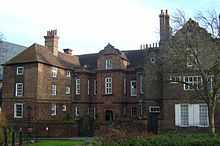Satis House
Satis House is a fictional estate in the Charles Dickens novel Great Expectations.
Satis House is the home of Miss Havisham, a rich woman, heiress to her father's fortune, who was abandoned by her intended husband on her wedding day. In rage and disappointment, she "lays waste" to the buildings and grounds, even stopping the clocks at the exact time she learned of her lover's betrayal (twenty minutes to nine).
The name Satis House comes from the Latin satis for 'enough', and is the name of a real mansion in Rochester, Kent, near where Dickens lived. It gained its name from a comment by Queen Elizabeth I who stayed there as a guest of the owner, Richard Watts. As she left, Watts asked his queen if she had been comfortable during her stay. Offhandedly, she replied: "Satis".[1]

According to Dickens' biographer John Forster, the novelist also used aspects of the nearby Restoration House.[2][3] [4]
The character Estella Havisham, Miss Havisham's adopted daughter, discusses the name with Pip, the protagonist:
- Pip: 'Is Manor House the name of this house, miss?'
- Est.: 'One of its names, boy.'
- Pip.: 'It has more than one, then, miss?'
- Est.: 'One more. Its other name was Satis; which is Greek, or Latin, or Hebrew, or all three—or all one to me—for enough.'
- Pip: 'Enough House,' said I; 'that's a curious name, miss.'
- Est.: 'Yes,' she replied; 'but it meant more than it said. It meant, when it was given, that whoever had this house, could want nothing else. They must have been easily satisfied in those days, I should think. [...]'
Satis House reflects the corruption, decay, and fate of its owner. In the novel, the building is destroyed after its owner's death, but its fate varies in the better known dramatic adaptations. In the most famous film production of Great Expectations, the 1946 version, the building remains in its corrupted state to serve as a setting for the final scene. In the mini-series version of 1989, the estate survives until the last scene but is due to be torn down.
It is described by Pip (the main character) in chapter 8. He notes the iron bars in the windows of the house; also including some detail on the boarded-up window. There is also a large brewery on the side of the house connected to the house by lanes and an open wooden gate.
References
- ↑ city of Rochester.org.uk
- ↑ "John Forster, "The Life of Charles Dickens" (8)". www.lang.nagoya-u.ac.jp. Retrieved 2009-12-06.
- ↑ "Restoration House reveals its history" Medway Council press release, 2006-07-25. Accessed 2006-11-22.
- ↑ city of Rochester.org guided tours
| ||||||||||||||